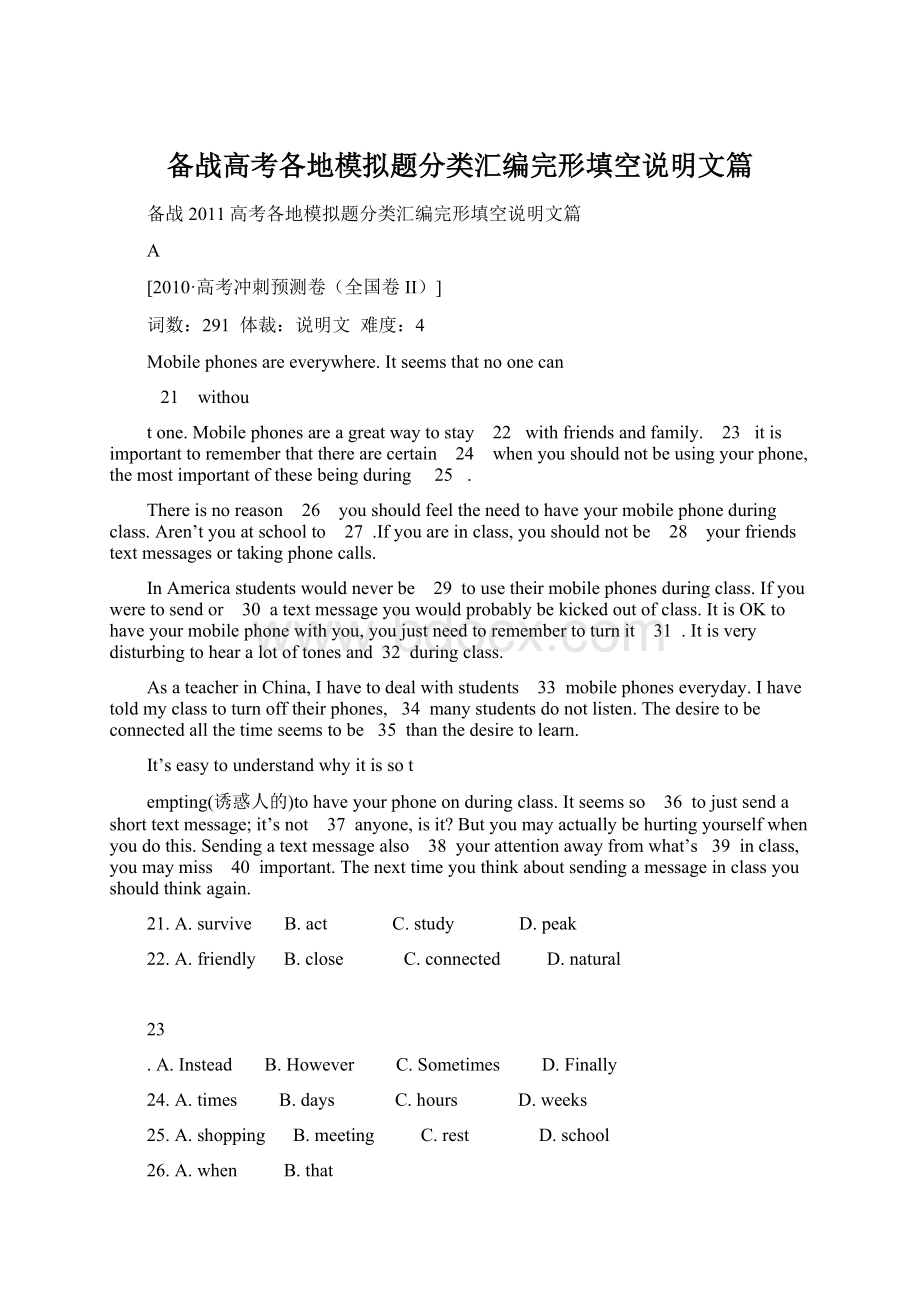 备战高考各地模拟题分类汇编完形填空说明文篇.docx
备战高考各地模拟题分类汇编完形填空说明文篇.docx
- 文档编号:11726368
- 上传时间:2023-03-31
- 格式:DOCX
- 页数:6
- 大小:22.31KB
备战高考各地模拟题分类汇编完形填空说明文篇.docx
《备战高考各地模拟题分类汇编完形填空说明文篇.docx》由会员分享,可在线阅读,更多相关《备战高考各地模拟题分类汇编完形填空说明文篇.docx(6页珍藏版)》请在冰豆网上搜索。

备战高考各地模拟题分类汇编完形填空说明文篇
备战2011高考各地模拟题分类汇编完形填空说明文篇
A
[2010·高考冲刺预测卷(全国卷II)]
词数:
291 体裁:
说明文 难度:
4
Mobilephonesareeverywhere.Itseemsthatnoonecan
21 withou
tone.Mobilephonesareagreatwaytostay 22 withfriendsandfamily. 23 itisimportanttorememberthattherearecertain 24 whenyoushouldnotbeusingyourphone,themostimportantofthesebeingduring 25 .
Thereisnoreason 26 youshouldfeeltheneedtohaveyourmobilephoneduringclass.Aren’tyouatschoolto 27 .Ifyouareinclass,youshouldnotbe 28 yourfriendstextmessagesortakingphonecalls.
InAmericastudentswouldneverbe 29 tousetheirmobilephonesduringclass.Ifyouweretosendor 30 atextmessageyouwouldprobablybekickedoutofclass.ItisOKtohaveyourmobilephonewithyou,youjustneedtoremembertoturnit 31 .Itisverydisturbingtohearalotoftonesand 32 duringclass.
AsateacherinChina,Ihavetodealwithstudents 33 mobilephoneseveryday.Ihavetoldmyclasstoturnofftheirphones, 34 manystudentsdonotlisten.Thedesiretobeconnectedallthetimeseemstobe 35 thanthedesiretolearn.
It’seasytounderstandwhyitissot
empting(诱惑人的)tohaveyourphoneonduringclass.Itseemsso 36 tojustsendashorttextmessage;it’snot 37 anyone,isit?
Butyoumayactuallybehurtingyourselfwhenyoudothis.Sendingatextmessagealso 38 yourattentionawayfromwhat’s 39 inclass,youmaymiss 40 important.Thenexttimeyouthinkaboutsendingamessageinclassyoushouldthinkagain.
21.A.survive B.act C.study D.peak
22.A.friendly B.close C.connected D.natural
23
.A.Instead B.However C.Sometimes D.Finally
24.A.times B.days C.hours D.weeks
25.A.shopping B.meeting C.rest D.school
26.A.when B.that
C.why D.where
27.A.play B.learn C.help D.fight
28.A.sending B.writing C.posting D.retaining
29.A.hoped B.wished C.allowed D.encouraged
30.A.keep B.help C.take D.receive
31.A.on B.in C.out D.off
32.A.ringing B.sound C.voice D.shouts
33.A.thinking B.using C.considering D.bringing
34.A.and B.so C.but D.then
35.A.faster B.stronger C.lower D.easier
36.A.cheap B.hard C.easy D.brave
37.A.hurting B.meeting C.knowing D.killing
38.A.pays B.puts C.breaks D.takes
39.A.comingon B.goingthrough C.goingon D.comingby
40.A.everything B.something C.anything D.nothing
【文章大意】手机给人们带了沟通上的方便。
可是对于学生而言,把手机拿到课堂上发信息和打电话会严重影响学习和课堂秩序。
作者以一位教师的身份阐释了手机给学生们带来的巨大魅力和学习上的影响。
21.A根据文章首句可知,手机随处可见,对人们的影响是巨大的,本题中的survive意为“存活,幸免于难”与语境相符。
22.C 此处stayconnectedwithsb.“与某人保持联系”。
friendly“友好的”;close“亲近的”;natural“自然的”。
23.B前句说到手机是人们的交流工具,后一句就提出了它的劣势,因此根据该空的逻辑关系可以判断出前后为转折关系。
However“然而”,与语境相符。
24.A 根据句意和常识理解,手机虽然是人们必不可少的交流手段,但是某些时候
手机也是应该限制使用的。
certaintimes“某些时候”。
该空所在的这句话就是引出下文。
25.D根据第二段中“atschool,inclass”等词可以判断作者要引出的话题是手机在校园中被使用的某些情况。
26.C Thereisnoreasonwhy…意为“做某事没有原因”。
27.B 根据下一句话“Ifyouareinclass,youshouldnotbe 43 yourfriendstextmessagesortakingphonecalls.”可知,学生在学校就是该学习,作者用反问的方式进行了语气上的强调,句意为:
“难道你在学校不是为了学习吗?
”
28.A作为学生,课堂上发送信息是不应该的。
sendtextmessages“发信息”。
postin9“邮寄”;writing“写”;retaining“
保持”。
29.C句意为:
“在美国学生是不允许在课上使用手机的。
”根据下文提示可知,这为一项规定,beallowedtodo“被允许做某事”。
30.D上文中提到美国学生不许将手机带人课堂,而且该空与send相对应,故填入receive意为“接收短信”。
31.D turnoff“关闭”;turnon“打开”;根据下文的“Itisverydisturbingtohearalotoftonesand47duringclass.”可知,只有手机关掉才不打扰别人。
32A通过上下文可知,在课上把手机关掉才能听不到令人厌烦的声音和铃声。
Ringing在此处为名词性质,即“铃声”。
33B根据常识可知,作者作为一名教师,肯定会处理学生每天使用手机的情况。
Consider“考虑,认为”,用在该空不符合句意。
Usemobilephones“使用手机”。
34C根据上文可知教师让孩子们关掉手机,可是在下文中提到了很多学生根本不听。
这就说明上下文为转折关系,故用but。
35B通过本段中所讲内容可以推断出,孩子们更热衷于用手机取得联系或是被联系,因此作者认为对孩子们来说“用手机随时联系的欲望比上课的欲望更强烈。
”其余几项均与语境不符。
36.C根据上下文的行文逻辑判断,作者再次利用反问的形式进行了语气上的强调表明自己的态度。
句意为:
“似乎在课上发条短信是很简单的事情,不会伤害别人,是吗?
”
37.A 根据下句中的“…behurting
yourselfwhen…”提示可知。
38.D该句意为:
“当你真地在课上发信息的话,这一行为会害了自己,因为它会将你的注意力从课堂上带走。
”take“带走,拿走”与语境相符。
39.C comeon“加油,过来”;goon“进行,进展”;gothrough“通过”;comeby“过去”。
由语境知选C项。
40.B联系上文可知,如果学生在课上将注意力集中在玩手机上,这样的话就会错过课上的一些重要的知识,并不是全部知识。
B
[2010·河南示范性高中五校4月联考]
词数:
333 体裁:
说明文 难度:
4
Peopledonotanalyseeveryproblemtheymeet.Sometimestheytrytorememberasolutionfromthelasttimetheyhada36 problem.Theyoftenaccepttheopinionorideasofotherpeople.Othertimestheybegintoactwithout37;theytrytofindasolutionbytrialanderror.However,whenallofthesemethods38,the
personwithaproblemhastostartanalysing.Therearesix39inanalysingaproblem.
40,thepersonmustrecognizethatthereisaproblem.Forexample,Sam’sbicycleisbroken,andhecannotrideittoclassasheusuallydoes.
Sammust41thatthereisaproblemwithhisbicycle.
Nextthepersonmust42theproblem.BeforeSamcanrepairhisbicycle,hemustknowwhyitdoesnotwork.Forexample,hemust43thepartsthatarewrong.
Nowthepersonmustlookfor44thatwillmaketheproblemclearerandleadto45solutions.Forexample,supposeSam46thathisbikedoesnotworkbecausethereissomethingwrongwiththebrakes.47,hecanlookinhisbicyclerepairbookandreadaboutbrakes,talktohisfriendsat thebikeshop,orlookathisbrakescarefully.
After48theproblem,thepersonshouldhaveseveralsuggestionsforapossiblesolution.TakeSamasanexample49,hissuggestionsmightbe:
tightenorloosenthebrakes;buynewbrakesandchangetheoldones.
Intheend,one50seemstobethesolutiontotheproblem.Sometimesthe51ideacomesquite52becausethethinkersuddenlyseessomethingina53way.Sam,forexample,suddenlyseesth
ereisapieceofchewinggumstucktoabrake.Heimmediatelyhitsonthesolutiontohisproblem:
hemust54thebrake.
Finallythesolutionis55.Samdoes
itandfindshisbicycleworksperfectly.Inshorthehassolvedtheproblem.
36.A.serious B.usual C.similar D.common
37.A.practiceB.thinking C.understandingD.help
38.A.fail B.work C.change D.develop
39.A.ways B.conditions C.stages D.orders
40.A.First B.Usually C.Ingeneral D.Mostimportantly
41.A.explain B.prove C.show D.see
42.A.judge B.find C.describe D.face
43.A.check B.determine C.correct D.recover
44.A.answers B.skills C.explanation D.information
45.A.possible B.exact C.real D.special
46.A.hopes B.argues C.decides D.suggests
47.A.Inotherwords B.Oncein
awhileC.Firstofall D.Atthistime
48.A.discussing B.settlingdownC.comparingwith D.studying
49.A.secondly B.again C.also D.alone
50.A.suggestion B.conclusion C.d
ecision D.discovery
51.A.next B.clear
C.final D.new
52.A.unexpectedly B.late C.clearly D.often
53.A.simple B.different C.quick D.sudden
54.A.clea
n B.separate C.loosen D.remove
55.A.recorded B.completed C.tested D.accepted
【文章大意】只是一篇说明文,通过举例说明了解决问题的六大步骤。
文章浅显易懂,逻辑性强。
36C人们不总是对遇到的每一个问题进行分析。
他们往往试图记起上次遇到与之相似的问题时的解决办法。
37B此处withoutthinking意为:
不假思索,可根据bytrialanderror(反复试验)判断。
38A从上下句的关系看,它们是转折关系。
当这些方法都失败后他们就会开始分析。
39C此处stage的意思是“步骤”。
分析问题有六个步骤。
40A上文中提到分析问题有六个步骤,自然这是第一个步骤。
41D此处see在这句话中意为:
明白。
当Sam的自行车不能正常使用时,他应该明白自行车出了毛病。
42B要解决问题,当然要找到问题所在。
43B第二步要找到问题所在,所以选determine“测定,找出”,与findout意思相同。
44D根据下文Sam所做的事情可知,要了解问题的相关信息才能修理,所以选information。
45A了解相关信息,使问题明朗化,寻求可能的解决办法。
46C结合逻辑在修自行车之前,要先“确定”是自行车的那个部件出了问题。
47D当Sam是自行车的闸出了问题之后,这时他就可以进一步采取措施了。
此处atthistime的意思是“这时”;Inotherwords换句话说;Onceinawhile偶尔;Firstofall首先。
48D研究了问题后(人们)就可能提出一些解决建议。
此处study不仅有“学习”的意思,还有“研究”的意思。
49B仍然以Sam修自行车为例,所以填again。
50A其中一个建议会解决问题。
51C最终的解决方法有时来得出人意料。
52A见上文解析。
53B因为想解决问题的人突然发现了一些东西,直接就找到了症结所在,而这这种方法与上文所述是不同的。
54A去掉口香糖的方法是清理车闸。
55C只有经过检验,才能
证明解决问题的方法的正确性。
()
- 配套讲稿:
如PPT文件的首页显示word图标,表示该PPT已包含配套word讲稿。双击word图标可打开word文档。
- 特殊限制:
部分文档作品中含有的国旗、国徽等图片,仅作为作品整体效果示例展示,禁止商用。设计者仅对作品中独创性部分享有著作权。
- 关 键 词:
- 备战 高考 各地 模拟 分类 汇编 填空 说明文
 冰豆网所有资源均是用户自行上传分享,仅供网友学习交流,未经上传用户书面授权,请勿作他用。
冰豆网所有资源均是用户自行上传分享,仅供网友学习交流,未经上传用户书面授权,请勿作他用。


 《雷雨》中的蘩漪人物形象分析 1.docx
《雷雨》中的蘩漪人物形象分析 1.docx
